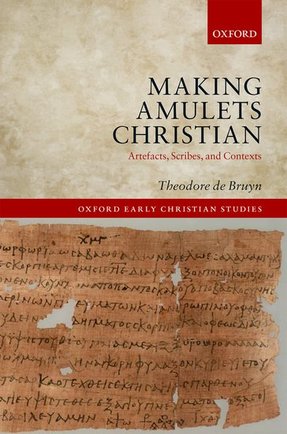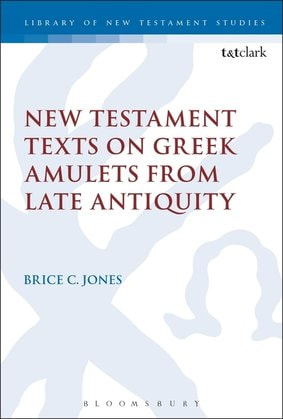 I am excited to announce a forthcoming book on Christian amulets: Theodore de Bruyn, Making Amulets Christian: Artefacts, Scribes, and Contexts (Oxford: OUP, 2017). The book is scheduled for release in late August. As readers of this blog probably know, I have a keen interest in amulets. My first major monograph analyzed New Testament citations in Greek amulets and Prof. Theodore de Bruyn's work is cited many, many times. His scholarship speaks for itself. Prof. de Bruyn was kind enough to read several portions of my doctoral dissertation and to answer many questions along the way. Needless to say, this is a book that has been needed for a long time. Amulets have popped up in early Christian studies here and there, but they have largely been ignored, in my opinion. There are so many interesting questions related to the production of amulets, including scribal activities, ritual and social practices, transmission of scripture, Christian symbols, adaptations, "magic," liturgical influences, "syncretism," use by women, etc. I am currently beginning to write an article on the reception of Jesus and Jesus traditions in Christian amulets, an avenue that has not been explored at all. So, I'm very glad to see that amulets are beginning to draw more and more attention by early Christian scholars. I think part of the reason for this is that more and more amulets continue to be identified and published. (I am working together with a colleague on a very interesting papyrus amulet that should be published within a year so stay tuned!) A broad historical study of Christian amulets has been needed, and now that need has been met with the publication of this monograph. Note: The papyrus on the cover is P.Oslo 1.5, a fourth/fifth century Greek amulet against scorpions, snakes, demons, witchcraft, and every kind of evil in a house, with "magical" and Christian characters. I briefly describe it on p. 31 of my book. [The following is taken from Oxford University Press' website] DESCRIPTION Making Amulets Christian: Artefacts, Scribes, and Contexts examines Greek amulets with Christian elements from late antique Egypt in order to discern the processes whereby a customary practice--the writing of incantations on amulets--changed in an increasingly Christian context. It considers how the formulation of incantations and amulets changed as the Christian church became the prevailing religious institution in Egypt in the last centuries of the Roman empire. Theodore de Bruyn investigates what we can learn from incantations and amulets containing Christian elements about the cultural and social location of the people who wrote them. He shows how incantations and amulets were indebted to rituals or ritualizing behavior of Christians. This study analyzes different types of amulets and the ways in which they incorporate Christian elements. By comparing the formulation and writing of individual amulets that are similar to one another, one can observe differences in the culture of the scribes of these materials. It argues for 'conditioned individuality' in the production of amulets. On the one hand, amulets manifest qualities that reflect the training and culture of the individual writer. On the other hand, amulets reveal that individual writers were shaped, whether consciously or inadvertently, by the resources they drew upon-by what is called 'tradition' in the field of religious studies. TABLE OF CONTENTS List of Abbreviations A Note on References Introduction 1. Normative Christian Discourse 2. Materials, Format, and Writing 3. Manuals of Procedures and Incantations 4. Scribal Features of Customary Amulets 5. Scribal Features of Scriptural Amulets 6. Christian Ritual Contexts Conclusion Bibliography
0 Comments
Your comment will be posted after it is approved.
Leave a Reply. |

Available at Amazon!
Archives
June 2020
Categories
All
|